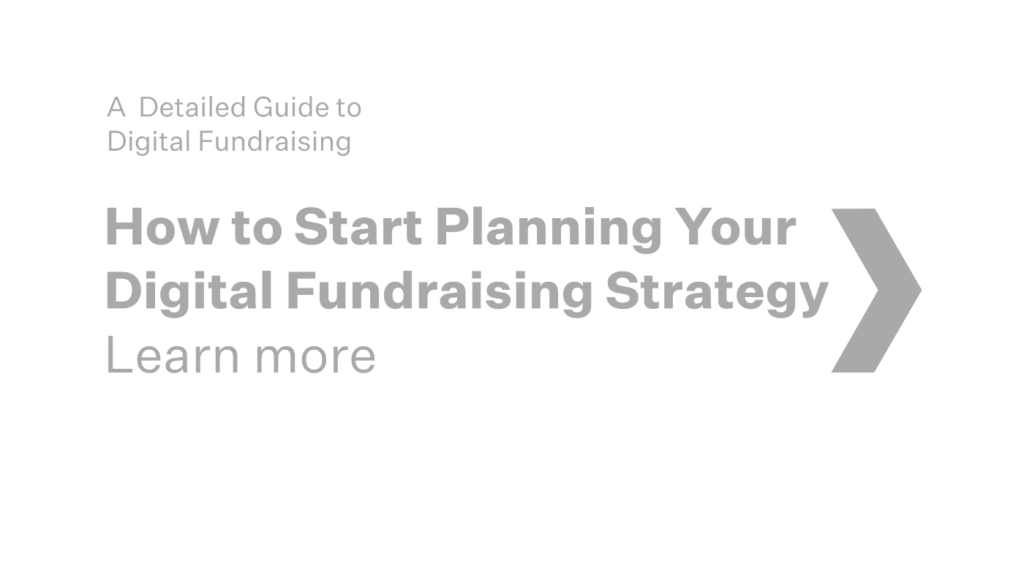
This article is part of the series, “A detailed Guide to Digital Fundraising”. Read the Table of Contents for a full list of articles.
The key to effective digital fundraising is in the planning. Mapping out every step of a campaign and the overall workflows you are going to create and manage is crucial to success. The more effort you put into planning, the easier it is to execute as you will always have a point of reference to stick to and fall back on. It is also important to document your approach, systems and processes, so that what you do can be shared internally and replicated. This allows aspects of the work to be delegated or managed by others. If you intend to grow your digital fundraising activities, creating an internal record of how it works means you can scale it properly and apply additional resources when necessary.
2.1 BUSINESS PLAN
First things first, it’s important to understand the overall business strategy. This initial stage has nothing to do with digital and is all about gaining an understanding of what the plans and objectives are for the business as a whole. What is the company looking to achieve in the next one to five years in terms of revenue growth, employees, products, services or markets? What are the trends within your sector and how can you be in the right place to influence or shape them?
Your digital strategy needs to become an extension of your organisation’s business plan, so making sure that people understand it, is an important first step. A useful exercise is creating a business model canvas that takes your interpretation of the business plan and puts it all together to understand some of your key differentiators. Here is an example of how to complete one.
The more developed the plan, the more campaigns you will likely have to develop. Very often these will not just be focused on finding new donors or investors, they might be adjusting your positioning, perception or enhancing your reputation with existing investors, or focusing on keywords that will become more popular in the next year or so. In this respect, the role of digital fundraising is intrinsically connected to your communications, PR, marketing and sales strategy.
2.2 CALENDAR MAPPING
The next step is to review what is happening over the course of the year. This can often seem like a daunting task, so it might be more manageable to tackle this on a quarterly basis. By listing all key events, dates and business goals for each quarter, it enables you to determine the most appropriate time to run your campaigns. Clear visibility on what is going on for the next 52 weeks will allow you create and launch campaigns in a timely fashion and therefore avoid any last minute scrambles!
We use the expression “let your subconscious do the heavy lifting”, the more time you have to think about things in the background, the better the final outcome will be. Nobody likes being sprung an important project without enough time and it happens all too often. It’s advisable to create a project folder for each campaign – no matter how far away it might be – so that you are able to add assets or drop thoughts into a document at any time so that you are passively building relevant information as you go about your daily work.
Also, by planning for the financial or calendar year, you might be able to structure your campaigns in a way that supports other events that are taking place during the year. Sector events, conferences, seasons or holidays might be a good way to synchronise the launch of a particular campaign, product or fund.
In our distribution chapters we will explore the optimal times to launch individual campaigns in relation todays of the week, time zones, lead times for launching and marketing a campaign with specific target dates or types of events in mind.
2.3 TIMELINE FOR A CAMPAIGN LAUNCH
This will also be covered later, but a reasonably standard amount of time to create an individual campaign should be 2 months. As you get better at managing your templates and systems for planning, generating content and distribution, these timelines can be shorter. It’s important to remember that some of the best campaigns are reactive to events that happen on a day-to-day basis, so don’t feel restricted to the timeline . Most standard campaigns with a fixed date for launch should take 2 months to prepare. This also gives time for the creation of content, depending on the medium – video can sometimes take longer to produce, again depending on the concept, or where it sits.
2.4 CAMPAIGN OBJECTIVES
Now that you know what the basic plans are, it’s important to determine your campaign objectives. The more targeted you are, the better the campaign will be. Do not try to be all things to all people, think clearly back to your business plan and see how your campaign can help support them.
Here are the three basic areas:
2.4.A. BUSINESS OBJECTIVES
What do you want to achieve? When launching any campaign, it’s critical to determine a set of KPIs and conversions to help determine whether your campaign is a success. The more specific you are, the better your campaign will be. What is the main aim? Is it brand awareness, more customers or subscribers? Whatever it might be, make sure you are as specific as possible and clearly assign a metric to that conversion or KPI e.g. 1000 new followers on LinkedIn, 500 new subscriptions to a newsletter or investment alerts, 10 new meetings, enquiries or investors.
2.4.B. COMMUNICATIONS OBJECTIVE
What do you want to say? What is the key message that you want to convey? It is easier to complicate than to simplify, so try and keep your communications objective to one central message and try not to keep adding things. In promoting a campaign to new prospects, you only have a limited amount of time to capture their attention, so be as clear as possible and try and make sure the message resonates. Our brain processes images 60,000 times faster than text so it is also helpful to think about visuals that can also help support your message.
2.4.C. AUDIENCE
Who do you want to reach? When identifying audiences, think about their sector, geography, demographic, companies, roles and interests. Your audience can be developed over time and can cover a variety of areas outside of your target customers and addressable market. It is always worth conducting additional market research to see whether you can tap into audiences that you originally didn’t consider – mapping out the decision making process helps you identify different people and advisers that may be involved at different stages of securing an investment.
You may want to go back over these three points a few times to make sure they are refined and complement each other as much as possible. The objective, message and audience should all be tightly connected with each other. You can also rotate different audiences with other campaigns and events during the year.
We will go into developing custom audiences in further detail, later in the series.
2.5 LEGAL + COMPLIANCE
It is important to make sure you are well versed in the regulations and policies that govern your sector and organisation. Ensure you have the proper understanding of what your regulations are and that you are compliant. There are many directives and regulations being rolled out at the moment so make sure you seek counsel before launching any campaign and stay on top of them as they change.
2.5.A. REGULATIONS
Before you embark on any digital fundraising activities it is important that you review and understand the regulations within the sector and markets you operate. There are a variety of resources that each industry can reference. A large amount of the challenges that organisations face are common and consistent from sector to sector. Charities face challenges around restricted and unrestricted funds, how they are presented, obtained and how funds are used. Listed businesses are not allowed to make forward looking statements or comparisons and have to control how new announcements are made. Investment management firms are regulated in terms of how their investments are presented and marketed. Here are a few thoughts and resources for each sector within the UK.
- Financial services – Thomson Reuters Practical Law
- Finance – Thomson Reuters Practical Law
- Listed businesses. LSE Rules + Regulations
- Charities – UK Fundraising Regulator Code
2.5.B. POLICIES
Policies can also change from organisation to organisation. Compliance can be very restrictive and precautions are put in place for a reason, usually to protect the investor and to clearly present the liabilities, risks, costs, expectations or potential losses that can occur as a result of an investment. In short, your policies should be honest, simple, transparent and easy to understand.
2.5.C. DATA PRIVACY + GDPR
As digital fundraising places an emphasis on building data, you also need to have a clear understanding of how you are collecting and managing data. Most organisations should have a DPO (Data Protection Officer). The role of the DPO is to have a representation of the processes used, protocol for breaches and a way to handle access data requests. Here is an article on GDPR.
2.6 TEAMS + RESPONSIBILITIES
One of the most important aspects of planning a successful campaign is assigning the right individuals to different tasks. This area is often overlooked but it will have significant impact on how smoothly your campaign runs. Once you feel that everyone is in the correct position, determine who is reporting to who and create a process for how key decisions are to be made.
This series is created by 52 Group. 52 has three divisions focused on helping investment management firms, charities and listed businesses raise and deploy capital. If you would like to receive digital fundraising insights from 52, please sign up to receive our “Raise + Deploy” news.
